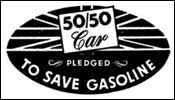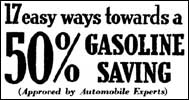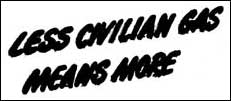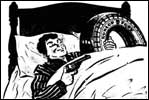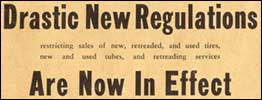This effort proved to be inadequate and by December the announcement was made that rationing would go into effect 1 April 1942. On top of this announcement, civilians learned that the sale of all new rubber tires had been halted. There was also an extreme cutback in automobile production. A Journal editorial in January 1942 praised the benefits of walking.
 In preparation for the rationing, users were divided into categories. Category A was the designation for the average motorist. There were four other categories, labeled B - E, plus a separate one for commercial users. No gas could be obtained after 1 April without the proper coupons.
In preparation for the rationing, users were divided into categories. Category A was the designation for the average motorist. There were four other categories, labeled B - E, plus a separate one for commercial users. No gas could be obtained after 1 April without the proper coupons.Shortly after the program got underway, the speed limit was reduced to 40 miles an hour. In August, the Wartime Prices and Trade Board announced that after 1 November private truck owners must have special permits to travel more than 35 miles from home.
Businesses had their own restrictions. Local merchants who had used vehicles to make deliveries were obliged to limit the number of trips they could make per day or week. Some placed notices in the newspapers informing customers of their delivery schedule, and supplemented their service with bicycles and horse and wagon. Often deliveries in the downtown were made on foot.
 Bicycles also came under wartime restrictions. In order to get a new one, a potential buyer had to complete a Bicycle Purchase Application Form. There were four classifications under which a person could apply. CCM ads advised consumers that their dealers were ready and able to repair and service any of their bicycles.
Bicycles also came under wartime restrictions. In order to get a new one, a potential buyer had to complete a Bicycle Purchase Application Form. There were four classifications under which a person could apply. CCM ads advised consumers that their dealers were ready and able to repair and service any of their bicycles.In February 1943, the Dept of Munitions and Supply made an announcement that revised gas rationing would go into effect 1 April 1943. Motorists were reminded in published messages that "Less civilian gas means more fighting gas for the forces."
Unfortunately, this shortage of such a sought-after commodity led to people acquiring gas through unsavory methods. Reports began to come in during 1944 of gasoline being siphoned from parked cars after dark. Many unfortunate citizens discovered that gas had been stolen from their automobile tanks while they were in the movie theatre or otherwise engaged.
 When the calendar rolled around to April 1945 gas rationing was once more extended, the allowance being the same as the previous year - " … the people of Canada are again reminded that they are only denied the free use of their cars in order that our armed forces may have all they require to bring the war to a successful conclusion."
When the calendar rolled around to April 1945 gas rationing was once more extended, the allowance being the same as the previous year - " … the people of Canada are again reminded that they are only denied the free use of their cars in order that our armed forces may have all they require to bring the war to a successful conclusion."At the same time that motorists were feeling the frustration of gas rationing, they also had to contend with the shortage of rubber tires. People were warned to take care of the tires on their vehicles. An editorial in the Journal in June 1942 advised, "Tires Will Not Last Forever."
Local garages such as Corney Brothers did a good business in repairing tires with a method called vulcanizing. They also had the necessary equipment for re-treading old tires. In 1944, synthetic rubber tires began to become available to consumers. Ads from manufacturers or suppliers recommended the virtues of their products.
By June 1945, the rationing on inner tubes was removed and the tire regulations were changed to allow an additional 35,000
 business vehicle owners eligibility for new tires. Workers such as salesmen, reporters, or taxi drivers requiring the use of an automobile for at least 75 % of their mileage also became eligible. Most car owners were obliged to wait longer until manufacturing facilities could switch from military to civilian production.
business vehicle owners eligibility for new tires. Workers such as salesmen, reporters, or taxi drivers requiring the use of an automobile for at least 75 % of their mileage also became eligible. Most car owners were obliged to wait longer until manufacturing facilities could switch from military to civilian production.| Related Articles | Related Images | Related Memories | Related Websites | Inflation Calculator |
| Home Page | Site Map | Contact Us | Wyatt Heritage Properties |


